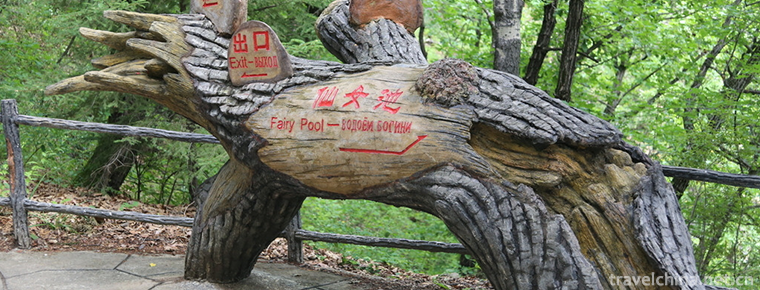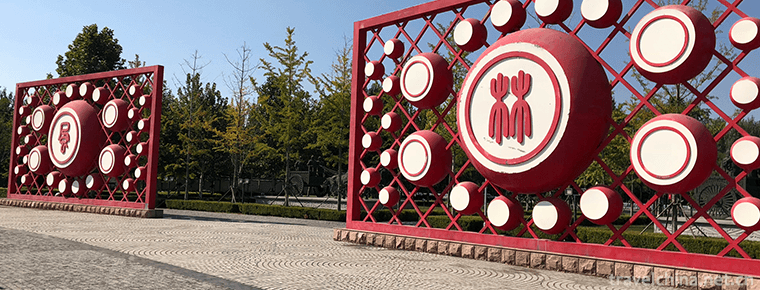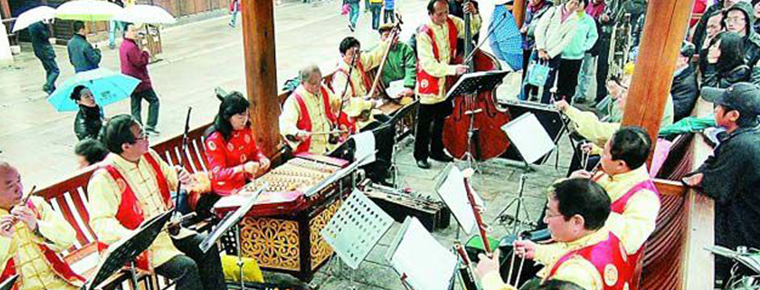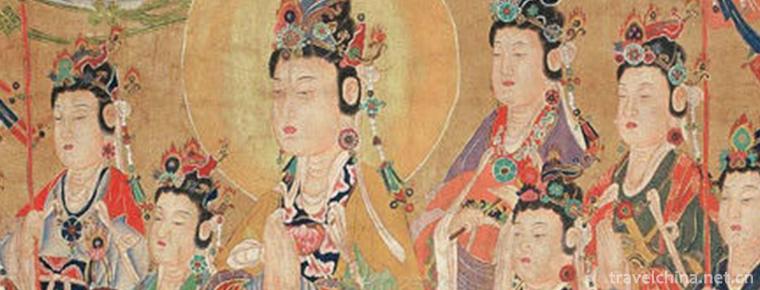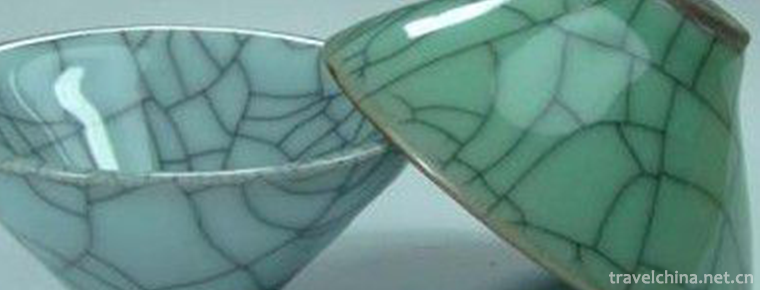Tune in the sea
Tune in the sea
Linhai Ci Tune, also known as Taizhou Ci Tune, Talent Ci Tune and Xianhe Tune, is developed from Nanci, Kunqu and Taizhou local folk minor. It is one of the folk songs of Taizhou, Zhejiang Province. It is spread in Linhai, Jiaojiang, Huangyan, Tiantai, Wenling, Xianju and other places. It is a kind of musical performance form that combines vocal tune, music and local dialect.
The melody of Linhai Ci Tune is mainly composed of "Ci Tune", scattered board, middle board, running board, etc. The language used in the lyrics is written in Taizhou; the instruments used are Erhu, Dongxiao, bamboo flute, three strings, pipa, yangqin, sandalwood board, bell-touching, etc., and Erhu is the main instrument; the rhythm of the performance is mainly graceful and peaceful.
In May 2005, Linhai Cidiao was listed in the first batch of intangible cultural heritage catalogues in Zhejiang Province, and in June 2008, it was included in the second batch of national intangible cultural heritage catalogues.
Historical evolution
Examination of origin
There are many opinions about the historical origin and specific formation age of Linhai Ci Diao. One is from the Southern Song Dynasty. According to the book "Linhai Culture History" written by modern scholar, Yiren and former librarian Xiang Shiyuan, "Ci Diao originated from Haiyan Diao created by Zhang Ang, a musician in the Southern Song Dynasty, and was sorted out and developed by Yang Zi, a dramatist in the early Yuan Dynasty. Haiyan Diao prevailed in Jia, Wen and Tai areas in the middle of Ming Dynasty. It evolved into intonation. It is also said that the tune of Ci evolved from Kunqu Opera, and even that the tune of Ci began in the Tang Dynasty. Whether the tune of Ci originated in the Tang Dynasty remains to be examined and studied. But in general, its history can be traced back to the Ming Dynasty. It is mainly formed by the integration of local folk songs with Haiyan and Kunshan tunes.
The people of Wen and Tai have been singing custom since ancient times. The so-called "Lixiang ballad" mainly refers to the folk ballads of Wen and Tai in Song Dynasty. In the Southern Opera Zhang Xie Zhuangyuan, there are "Taizhou Song" and "Dongsi Ling", which are taken from the place names of Taizhou and Wenzhou. Ci tunes are popular in the areas of Kunshan and Haiyan tunes, namely Wenzhou, Taizhou and Huzhou, while Haiyan and Kunshan tunes have evolved from the Southern Opera. In addition, the Southern Opera such as "Douyehuang", "Zhao Leather Shoes" and "Oil Walnut" are popular folk tunes in Taiwanese and Wenzhou areas. In addition, Linhai Cidiao also absorbs Kunqu Opera and folk ditties. The traditional melodies such as "Dian Jiang Lip", "Pink Butterfly" and "Lazy Thrush" all belong to Kunqu opera, and most of their repertoires come from the collection of Kunqu Opera compiled in Southern Opera and Qianlong Period.《 Baiqiu, others also come from Tanci and Baojuan, such as "Broken Bridge Meeting", "Drunken Restaurant Return", "Mink Zen worship the moon" and "Mad Monk sweep the Qin Dynasty".
Development and evolution
In the Song Dynasty, a group of excellent poets, represented by the poet Chen Ke, appeared in succession, and their works were often compiled into lyrics and songs by artists, which greatly promoted the development of Linhai's lyrics and songs art.
In the mid-Ming Dynasty, Haiyan Opera was prevalent in Jiaxing, Taizhou and Wenzhou. At the end of Ming Dynasty, it was combined with local folk songs and gradually evolved into "Ci Tune", which neither had scripts nor appeared on the stage.
In the Qing Dynasty, more than ten people, such as Song Shulan in Taicheng, made partial reforms and compiled scripts according to the characteristics of CI tunes, combining with the customs and characteristics of Linhai, thus forming a kind of sitting and singing music with strong local style, namely Linhai CI tunes.
Ci tune was at its peak from the mid-Qing Dynasty to the Republic of China. According to Xuan Shiyuan's "Ciyuan Music Trivial Talk" records: "Wutai Music Group has"written"and"near saint"two clubs. The organization of Chengwen Society began in Qingdao and Xian Dynasty. Its name was changed by words. Its learning was handed down from Tiantai, and most of its members were in itching order. In addition, there are other organizations of folk artists, such as "Zhaode", "Xiaoyao", "Fengyun", "Dong Feng" and "Yi Feng". Most of the members are literati and elegant scholars, known as "Chang Shi School". Therefore, "Linhai Ci Diao" also had a nickname of "talent Ci Diao" at that time. In the fourteenth year of Qing Daoguang (1835), Lin Xinpei, an outstanding artist of CI tune, and Shanduqu, wrote a gift song "Remembering Elegant Notes" when Hu Jipei left the stage. Dong Lin, Hong Zhenhao and others in the same period were well-known for their good singing skills.
During the period of Guangxu in the Qing Dynasty (1875-1808), a group of artists with excellent singing skills in CI and tune emerged, such as Song Shulan, Yang Yuewu, Zhou Xinfu, Qin Yuebo, Lin Xinpei, Dong Lin and Hong Zhenbao. Among them, those who were proficient in piano rhythm, proficient in music rhythm, and those who liked to adapt eyebooks were the most famous performers, Gao Xingji and Yu Qiusheng.
In the late Qing Dynasty, the tune of Ci was in a flourishing period, with hundreds of members joining the society. The main form of singing was sitting and singing. The biggest singing venue was a "fight party" (also known as "fight club") composed of middle-aged and old people, which prayed for the longevity of the sick and for disaster relief. At the same time, there were many folk free-combined sit-and-sing clubs all over the country. Apart from the gathering activities, members had festivals and holidays. Day, will also take turns at home to do pile, pile home only prepared a dish of melon seeds, a few cups of tea. Some low-level workers from poor backgrounds also come to "bare eggs fresh" in their spare time (Taizhou dialect, meaning that although they are poor, they are still optimistic) - and play with the tune. This is the "Short Dating School" as opposed to the "Long Shirt School" of laid-back children. "Short Da faction" accelerated the development and popularity of Taizhou Ci tone.
During the period of the Republic of China, Linhai Ci Tune was gradually bought and used by the feudal landlord class and developed into a noble style. It was often used to celebrate the birthday of the wealthy and to help the sons and daughters of official families after banquets and to sing at festivals. However, most of the singers only sang one or two songs and did not take any pennies, but they had to treat each other in a feast to show their elegant status. Daqing Shou, with twelve kinds of music cards, was a typical repertoire at that time.
Before the 1930s, all the participants were men. In the 23 years of the Republic of China (1934), Taiwanese Six Counties Joint Simple Normal School opened a class on Ci Tune in Ziyang Building, Ziyang Street. It absorbed a few female students, such as Jiang Guiqing, and rehearsed Daqing Shou, Legend of White Snake, Hunting and Meeting Mother, Horse Rong and Sending Family. The auditorium lasted four nights. From then on, Linhai pioneered women's stage performances, in which women acted as male actors and put their tunes on the stage in a more complete way. In the twenty-seventh year of the Republic of China (1938), in order to mobilize the whole nation to resist Japan, Linhai Ci was first put on the stage.
After the founding of the People's Republic of China, Linhai Ci has made great progress. In the 1950s, the Linhai Chengguan Amateur Ci Tune Troupe was established. In order to adapt to the convenience of teaching, singing and learning, Qiu Jiming and Ye Maosheng transcribed the scale score of Ci Tune into a simple score. Before and after 1959, they performed some traditional songs, such as "Broken Bridge Meeting" and "Mad Monk Sweeping Qin Dynasty". In addition, in the early 1950s, Wenling's ci-tune sitting choir performed such words as "Spring, Summer, Autumn and Winter" and "Fishing and Wood Cultivation Reading". In 1957, Wenling also created and performed "Farmhouse Music" and participated in Zhejiang Literature and Art Festival.
Since the spring of 1962, the traditional operas Fengyi Pavilion, Fisherman's Music, Mink Zen Moonworship, Class-to-Class and Small Comedy Monk-to-Nepal Pair have also been performed. In July of the same year, Linhai Culture and Education Bureau organized a performance team of Linhai Ci Tune, attended the Zhejiang Tanci Complete Book held by Zhejiang Cultural Hall, and performed Xiaobanquet and Broken Bridge in Ningbo in the form of sitting and singing.《 There are three programs, such as "Moon Salute". They include "Moon Salute", "Moon Salute", "Moon Salute", "Moon Salute", "Moon Salute", "Moon Salute" and "Moon Salute". In 1964, the amateur tone Club of Chengguan town in Lin Hai county has rehearsed many plays such as Fengyi Pavilion, Ma Rong sending to relatives, fishing house music, and the "monk and nun" and "Peony lesson *" and so on.
In the 1960s and 1970s, influenced by the Cultural Revolution, the Gang of Four pursued cultural autocracy. Linhai Ci tune was regarded as a product of "decadent decline" and was criticized. It was forced to stop all activities and was on the verge of being lost. After smashing the Gang of Four, Ci tune was reborn.
After the Third Plenary Session of the Eleventh Central Committee of the Communist Party of China, some folk artists, after digging, collecting and sorting out, returned to the stage and entered the people. Especially in January 1994, Linhai was approved as a national historical and cultural city. The CPC Linhai Municipal Committee and Linhai Municipal People's Government listed Linhai Ci Dialect as an important part of the historical and cultural city.
In May 2005, Linhai Ci Tiao was listed in the first batch of representative works of Zhejiang intangible cultural heritage by Zhejiang Provincial People's Government; in June 2008, Linhai Ci Tiao was selected into the second batch of national intangible cultural heritage list.
Quyi value
historical value
Ci-tune tune, ci-zao and music aria are the folk art forms of Jiangnan rap and singing art in Ming and Qing Dynasties, which are inherited in Taizhou area, and play an important role in the history of Jiangnan rap and singing art. At the same time, it plays an important role in studying the history and development of Nanxi Opera, Haiyan Opera and Kunshan Opera. Secondly, the lyrics of the tune are mainly composed of ancient poems and lyrics, and the contents are mainly based on folklore, historical stories and anecdotes. It is of great value to the study of social and historical customs and ancient Taizhou dialect at that time.
aesthetic value
The lyrics of Linhai Ci Tune are romantic, elegant, melodious, melodious and melodious. The accompaniment instruments are national instruments. Meanwhile, the literati's elegant singing words are round, singing three sighs, refreshing and refreshing. They have the style of ancient rhyme and the beauty of classical grace. At the same time, the performance of Ci Tune is often combined with folk customs. It is an art of elegant and custom appreciation and has great aesthetic value.
Humanistic value
The inheritance and development of Linhai Ci Tune plays an irreplaceable role in improving the people's cultural, musical and artistic literacy. Because Linhai Ci Tune melody is fresh and elegant, gentle and long, it plays a positive role in cultivating body and mind, cultivating sentiment and building a harmonious society under the circumstances of fierce competition and impetuous mentality in today's society.
Popular area
Linhai Ci Dialect takes Linhai as its birthplace and radiates to the surrounding areas. Besides being overseas, it also spreads in Huangyan, Jiaojiang, Wenling, Tiantai, Xianju and other places. As early as in Jiaqing, Daoguang and Xianfeng years of the Qing Dynasty, the tune of Ci was widely spread throughout Tiantai, with Shiling, Zuoxi, Lingxi and Torreya trees being the most popular in the countryside.
Inheritance and protection
Current situation
Although Linhai Ci Dialect has been restored and developed to some extent, the reality is still quite cruel.
First, Linhai Ci Tune requires musicians to play and sing by themselves, so it has a relatively small scope of singing, together with its Tao Bai and difficulty in singing, resulting in a situation of high and few tunes.
Secondly, Linhai Ci Diao is a folk form of music and art, an amateur local folk activity, oral and heart-to-heart teaching, is a "living" culture; and Linhai Ci Diao singers are generally old, whether sitting or performing on the stage can not be adapted, and relying on the oral and heart-to-heart teaching of several people alone can not carry forward this folk music.
Thirdly, the state pays more attention to intangible cultural heritage, and there are many researchers who study folk music in different places, but most of them only stay on the surface, without special and systematic excavation, collation and research. Linhai Ci Tune is no exception. The inheritance and development of this "folk music" is in an endangered state.
protective measures
Innovating the content of works
The development of society will make people have different understanding and change of the ideological and emotional content of the works, as well as the Linhai Ci Tune. People are no longer satisfied with the existing traditional plays, and have higher requirements for the artistic expression of the works. It is particularly urgent to innovate and create music.
Therefore, artists have transplanted and created traditional operas. A number of new repertoire have appeared. For example, Shao Zhigen and Song Zhi Ren's new work, "the eternal monument of Jiangnan the Great Wall", adopted the two tone polyphonic writing method of leading chorus and chorus, breaking through some inherent programs, such as modern drama "red tube house", "returning pig", "a rope" and so on. There are many new changes in singing and accompaniment. Leather and Creation.
Publishing books
In 1978, the Linhai County Cultural Bureau organized the compilation of 29 pieces of the traditional melody of Linhai Ci Diao.
In 1985, Linhai County Cultural Museum reorganized and compiled CI tunes into the book "Linhai Folk Music Integration".
In January 2014, Zheng Yingzhong, Shen Jianzhong and Dai Xiangshang published a series of representative works on intangible cultural heritage in Zhejiang Province: Linhai Ci Dialect by Zhejiang Photography Publishing House.
Establishment of CI Opera Troupe
After the founding of the People's Republic of China, the amateur activities of Linhai Ci Diao still exist, and in some places they are "very frequent". According to statistics, there are Linhai Chengguan Ci Diao Amateur Opera Troupe, Tiantai Torreya Village Ci Diao Troupe, Wenling Chengguan Ci Diao Troupe, Linhai Chengguan Handicraft Ci Diao Troupe and so on.
In August 2000, Luo Lianxing and other actors spontaneously organized 35 performers to set up Linhai Ci Diao Theatre Troupe, rehearsed such programs as Fold Opera "Ying Hong", "Pair Classes" and "Zhu Buichen".
In 2017, with the support of Linhai Wenguang New Bureau, Linhai Starfire Ci Mixture was established.
- Intonation into Campus
In 2005, Linhai Wenguang New Bureau and Linhai Historic and Cultural City Research Association held a special symposium to discuss the deep excavation and proper protection of Linhai Ci tones. Luo Liansheng attended the Symposium and put forward his own idea - let Linhai Ci be transferred into the campus.
In 2009, on the advice of Luo Lianxing and Cheng Gongfang, music teacher of Linhai Huipu Experimental Primary School, a Spring Miao Ci Tune Art Troupe was set up in Huipu Experimental Primary School. Luo Lianxing acted as a tutor and was obliged to teach students skills.
In 2011, considering that teachers could not teach without textbooks, Luo Liansheng and Chenggong cooperated in compiling a textbook on Linhai Ci Tunes and donated thousands of copies to schools at their own expense.
Free admission training
In 2015, the Linhai Ci Dialect Institute was officially registered with the civil affairs department, with 38 artists and 18 performances per year, all of which are public welfare performances.
In 2016, Linhai Inheritance Center for intangible cultural heritage was established. In that year, it trained Linhai Ci Dialect II for 32 class hours, with more than 30 students. Since then, it has enrolled students for free inheritance every year and performed on holidays.
Providing financial support
In 2004, Zhejiang Provincial Department of Culture allocated 100,000 yuan for art protection fund to support and rescue Linhai Ci Dialect.
Selected non Heritage
In May 2005, it was listed in the first list of intangible cultural heritage in Zhejiang Province.
In June 2008, it was listed in the second batch of national intangible cultural heritage list.
Inheriting characters
Representatives
Southern Song Dynasty: Zhang Anchor
Early Yuan Dynasty: Yang Zi, Chen Ke and Yan Rui
Qing Dynasty: Lin Xinpei, Dong Lin, Hong Zhenjian, Gao Xingji, Yu Qiusheng, Qin Yuebo, Zhou Xinfu, Song Shulan and dozens of others.
Modern and contemporary: Yang Yuhu, Yang Wusheng, Su Minggong, Chen Jianhua, Ye Tongxing, He Gongwang, Jiang Guiqing, Qiu Jiming, Zhang Huayue, Chen Daniel, Luo Lianxing, Pan Lingling, Mou Zhiping, Chen Guofen, Hou Tingzhi, etc.
- Heritage
In 2008, Chen Daniu was listed as the first representative inheritors of provincial intangible cultural heritage in Zhejiang Province.
In 2016, Hou Tingzhi was listed as the fourth group of representative inheritors of intangible cultural heritage at the municipal level in Taizhou.
Honorary commendation
In 1964, the modern drama "returning pig" performed by the amateur tone club in Chengguan town of Lin Hai county was awarded the two prize of the music festival in Taizhou.
In 2004, Linhai Ci Diao Theatre Troupe participated in the second Taizhou Folk Drama Show. Lu Bu and Mink Cicada won three awards: Silver Award, Actor Award and Organizational Award.

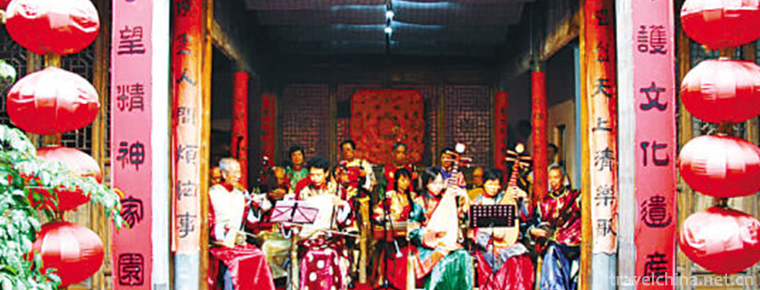
-
Maolangou National Forest Park
Maolangou National Forest Park is located in the northeastern part of Heilongjiang Province, at the northern foot of Xiaoxing'an Mountains and Xiangyang Township of Jiayin County,.
Views: 184 Time 2019-02-07 -
Sun Tzu Cultural Park
Sun Tzu Cultural Park is located in the East New Area of Guangrao County. It has been listed in the "four batches" key dispatching and promotion projects of the Yellow River Delta High Effic.
Views: 257 Time 2019-02-13 -
Tujia Style Garden
Zhangjiajie Tujia Style Park is located in Zhangjiajie City, a beautiful pearl. The Park covers an area of more than 80 mu with a total investment of 75 million yuan. It is a large-scale.
Views: 159 Time 2019-02-22 -
Acrobatics in Dongbeizhuang
Dongbeizhuang acrobatics is a traditional folk acrobatics in Puyang City. Dongbeizhuang, Yuecun Township in Puyang City, is a pearl in the vast plain of northern Henan Province.
Views: 112 Time 2019-04-27 -
Ping Ju Opera
Opera commentary is a kind of opera which is spread in the north of China. It is one of the most popular operas among the people and ranks among the five major Chinese operas. Some people once thought.
Views: 141 Time 2019-06-09 -
Ten times of music
Shifan music is a traditional instrumental music spread by Hakkas in Fuzhou and Western Fujian Province. It has been circulated since the middle of Daoguang in the Qing Dynasty. The origin of Shifan m.
Views: 307 Time 2019-06-15 -
Surface painting
Water and land painting Festival is a traditional religious painting. Originated in the Three Kingdoms Period, Buddhist monasteries prevailing from the Jin Dynasty to the Yuan, Ming and Qing Dynasties.
Views: 303 Time 2019-06-15 -
Firing Techniques of Wuzhou Kiln Ceramics
The traditional firing technique of Wuzhou kiln is a local traditional handicraft technique in Zhejiang Province. Wuzhou kiln is located in Tiedian Village, Langya Township, Jinhua City. Jinhua was na.
Views: 117 Time 2019-06-30 -
Beijing Institute Of Graphic Communication
Beijing Printing College is a full-time general higher education institution established by the Beijing Municipal People's Government and the former General Administration of Press and Publication. Th.
Views: 164 Time 2019-09-22 -
Huainan Normal University
The school was founded in 1958 when it was a teacher's College in Huainan. In 2000, approved by the Ministry of education, the former Huainan normal school, Huainan Education Institute and Huainan nor.
Views: 225 Time 2019-11-16 -
Guangan primary industry
In 2019, the sown area of grain in Guang'an City is 287000 hectares, and the total grain output is 1.8 million tons, an increase of 1000 tons or 0.04%. Among them, the rice output was 1.047 million tons, down 0.4%; the corn output was 448000 tons, an incre.
Views: 160 Time 2020-12-19 -
Dazhous secondary industry
In 2019, the added value of all industries in Dazhou is 46.35 billion yuan, an increase of 8.7% over the previous year, of which the added value of industries above Designated Size will increase by 9.6% (see Table 2). Among the industries above .
Views: 305 Time 2020-12-20
